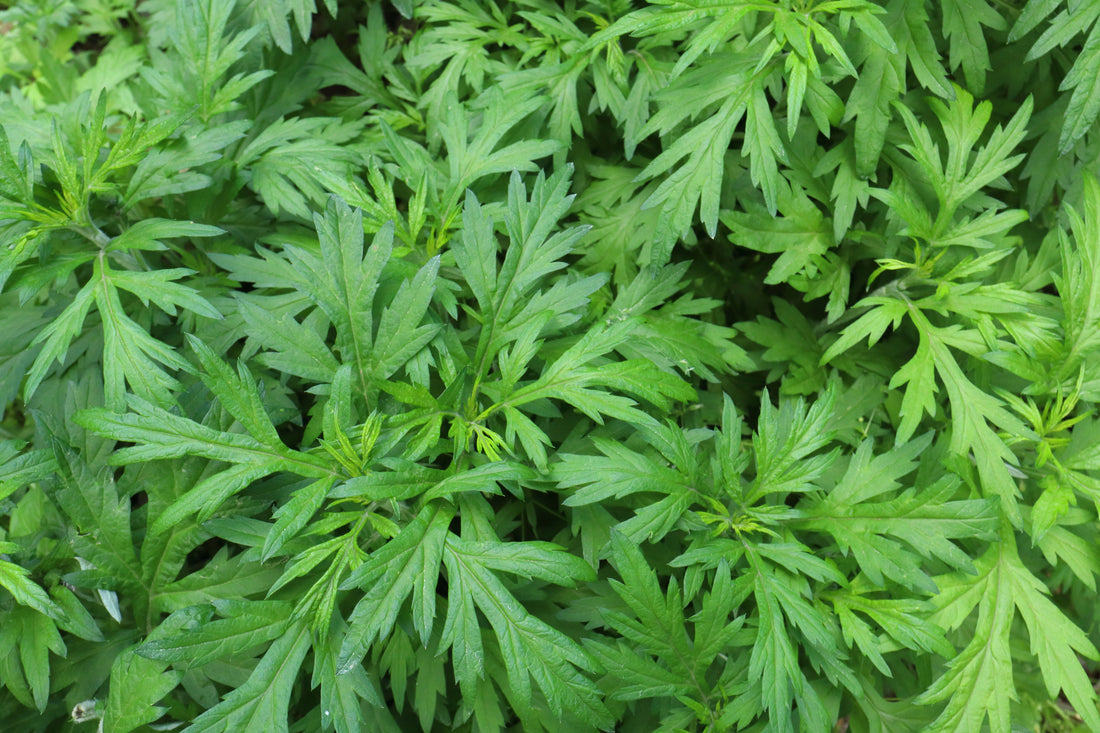Few herbs carry the rich cultural, medicinal, and culinary legacy of mugwort, known as ssook (쑥) in Korean and Artemisia vulgaris in scientific literature. Revered for centuries across Asia and Europe, mugwort remains a powerful symbol of health, resilience, and mindful living. Chefs’ demand for mugwort has been growing and we, Kim’C Market editors, decided to dive deeper into and introduce the amazing herb to Kim’C Market community.
1. Historical Prestige: The “Mother of Herbs”
 In medieval Europe, mugwort was known as the “mother of herbs,” a title reflecting its esteemed status as an essential plant for health and protection. People believed mugwort could ward off evil spirits, protect travelers from fatigue, and offer general vitality. This reputation carried across cultures, from Europe to Northeast Asia, where it became deeply rooted in traditional medicine, seasonal rituals, and cuisine.
In medieval Europe, mugwort was known as the “mother of herbs,” a title reflecting its esteemed status as an essential plant for health and protection. People believed mugwort could ward off evil spirits, protect travelers from fatigue, and offer general vitality. This reputation carried across cultures, from Europe to Northeast Asia, where it became deeply rooted in traditional medicine, seasonal rituals, and cuisine.
Traditional Medicine Across Cultures
In Europe, mugwort was traditionally used for digestive health, menstrual regulation, and protection against fatigue and infection. During the Middle Ages, travelers would place mugwort leaves in their shoes to prevent exhaustion on long journeys, believing its energy supported endurance. It was also a key ingredient in “gruit,” a herbal mixture used to flavor beer before hops became common, adding its distinctive bitter, aromatic notes to medieval brews.
In China, mugwort features prominently in moxibustion therapy to warm meridians, improve circulation, and expel cold and dampness. This practice involves burning mugwort over acupuncture points to stimulate healing and balance the body’s qi (vital energy). Beyond moxibustion, mugwort is used in traditional Chinese medicine as an herb to stabilize pregnancy and calm restless fetuses, reflecting its deep association with women’s reproductive health.
In Korea, mugwort is brewed into teas, cooked into rice cakes, used in broths and porridges, and incorporated into women’s health rituals such as V-steam (Chaiyok / 좌훈). Spring is particularly associated with mugwort harvesting, with grandmothers gathering fresh shoots to make soups (ssukguk) believed to purify the blood and energize the body after winter. Its role extends to temple cuisine, where monks and nuns use it for its detoxifying properties and gentle, grounding flavor.
2. Scientifically Supported Health Benefits

Modern phytochemical and pharmacological studies have validated many of mugwort’s traditional uses, offering scientific insight into why this herb has been revered for centuries. Research confirms its antioxidant properties, which help protect cells from oxidative stress and free radical damage, a key factor in aging and chronic disease prevention. Mugwort’s rich profile of flavonoids and polyphenols contributes to this protective effect, making it a valuable herb in supporting overall health and vitality.
Additionally, mugwort has demonstrated hepatoprotective effects, supporting liver function and detoxification. Traditional medicine often used mugwort to cleanse the body, and modern studies show it can help reduce liver inflammation and support healthy bile production, enhancing digestion and detox pathways.
Its antispasmodic effects have also been noted, relaxing muscles and easing cramps. This aligns with mugwort’s historical use for menstrual discomfort and digestive spasms, offering relief through its gentle muscle-relaxing properties.
Mugwort’s antinociceptive properties provide mild pain relief, making it useful for managing headaches, joint aches, and menstrual pains without the harshness of pharmaceutical painkillers. This natural analgesic effect contributes to its popularity in herbal remedies.
Furthermore, mugwort exhibits estrogenic activity, supporting hormonal balance, particularly beneficial for women’s wellness. Studies have linked its phytoestrogens to potential regulation of menstrual cycles and menopausal symptoms, reinforcing why it has been traditionally regarded as a herb for women’s health.
Finally, mugwort possesses antibacterial and antifungal properties, enhancing natural immunity and offering protection against various pathogens. This makes it useful not only in teas and broths for internal wellness but also in topical applications and skincare to calm irritation and protect the skin barrier.
(Source: Ekiert et al., Molecules, 2020)
3. Calming Energy Without Caffeine

Unlike green tea or matcha, mugwort is completely caffeine-free, offering a calming yet invigorating energy suitable for any time of day. Its earthy, slightly bitter notes create a warming infusion that soothes digestion and promotes relaxation without the jittery aftereffects of caffeinated drinks.
The Sober Curious Movement and Herbal Tea Popularity
As the “sober curious” movement gains traction globally, consumers are increasingly seeking non-caffeinated, functional beverages. Herbal teas like mugwort have become favored choices, aligning with a broader shift towards mindful consumption and natural wellness rituals.
4. Culinary Versatility: Ancient Ingredient, Modern Creativity
Mugwort Noodles

Adding mugwort powder to fresh noodle dough yields delicate sage-green noodles with subtle herbal aroma, enhancing dishes with both visual beauty and gentle bitterness. In Korea, suyeon somyeon (hand-pulled noodles) with mugwort flavor remains a seasonal specialty, often served cold in summer or hot in anchovy broth in winter.
Baked Goods and Desserts

Mugwort’s earthy notes lend themselves beautifully to baked goods. It pairs elegantly with:
-
Chestnut and black sesame in financiers or pound cakes
-
Sweet rice flour for traditional rice cakes (tteok)
-
Mochi brownies, creating an East-meets-West dessert with herbal depth
Michelin-starred restaurants such as Jungsik (New York City & Seoul) have incorporated mugwort ice cream with chestnut and black sesame as part of their innovative tasting menus, described by the Michelin Guide as an “innovative Korean reinterpretation.” Onjium, ranked No. 57 restaurant in the world in 2025, uses mugwort for its fantastic spring menus.
Ice Cream and Gelato

Imagine a mugwort gelato topped with honeyed walnuts: a sophisticated dessert that bridges tradition and modern palate preferences. Mugwort ice cream remains a popular spring and autumn menu addition in Seoul’s artisanal gelato shops. You can simply add organic mugwort powder.
Savory Pairings

In savory cooking, mugwort powder is mixed into batters for Korean pancakes (jeon), sprinkled over roasted sweet potatoes, or blended into rice balls (jumeokbap using Saechungmu White) to add an earthy complexity with a refreshing undertone.
5. Inspirations from Temple Cuisine

Temple food chef Jeong Kwan, featured on Netflix’s Chef’s Table, uses mugwort in broths and porridges for its purifying qualities, warming energy, and gentle bitterness. Her cooking philosophy embraces mugwort not just as an ingredient, but as a bridge to nature and inner peace.
6. Beauty and Spa Traditions

✨ Skincare Benefits
Mugwort is rich in anti-inflammatory, antibacterial, and antioxidant compounds, making it ideal for calming sensitive or irritated skin. In Korean skincare, mugwort is celebrated for restoring balance and strengthening the skin barrier. Big Korean beauty brands like Missha, I’m From, and Vely Vely have dedicated entire product lines to mugwort extracts, essences, and masks.
Spa Rituals: Mugwort V-Steam (Chaiyok / 좌훈)
For centuries, mugwort has been central to V-steam treatments in Korea, China, and Japan. Known as chaiyok in Korean, this herbal steam therapy was historically believed to support women’s reproductive health, improve circulation, and maintain overall vitality. Modern wellness spas continue to embrace mugwort steaming for its detoxifying and deeply relaxing benefits.
7. Mugwort’s Rising Global Popularity
Today, mugwort is experiencing a renaissance. While matcha has captured global attention over the past two decades—exemplified by the meteoric rise of cafés like Cha Cha Matcha and Matcha Café Maiko—mugwort is emerging as the next traditional superfood to captivate health-conscious consumers.
In the U.S., mugwort is being embraced within the wellness and alternative medicine industry for its calming, digestive, and immune-supportive benefits. The global mugwort market, including teas, powders, and even moxibustion products, continues to grow, reflecting rising consumer interest in natural, traditional remedies.
8. The Source Matters: Boseong’s Mugwort Excellence

High-quality Korean mugwort, especially from Boseong, Korea’s tea capital, is unparalleled. Grown in mineral-rich soils with clean ocean breezes and dramatic daily temperature swings, Boseong mugwort develops a robust flavor and deep green color.
At Bohyang Dawon, a fifth-generation family farm established in 1937, mugwort is grown organically, harvested by hand at peak potency, sun-dried, and finely milled to preserve its essential oils and natural nutrients. Each scoop embodies generations of ecological wisdom and quiet strength.
9. How to Use Mugwort Powder

First, Warm Mugwort Tea – Mix ½ teaspoon into 200ml warm water, stir well, and add honey or grain syrup for a smooth finish.
Second, Mugwort Latte – Blend into warm milk, oat milk, or soy milk for a cozy, caffeine-free herbal latte.
Third, Iced Mugwort Tea – Dissolve in cool water, shake, and pour over ice for a refreshing summer drink.
Last, Creative Culinary Uses – Add to yogurt, pancake or cookie batter, rice cakes, or homemade noodles for an herbal twist.
10. A Timeless Ingredient for Modern Life

Mugwort is more than a nostalgic herb. It is a versatile, healthful, and culturally rich ingredient that bridges ancient wisdom and modern creativity. As it finds its way into teas, desserts, noodles, skincare, and spa rituals, mugwort reminds us that true wellness is rooted in nature and tradition.
References
-
Ekiert, H. et al. (2020). Significance of Artemisia vulgaris L. (Common Mugwort) in the History of Medicine and Its Possible Contemporary Applications. Molecules, 25(19), 4415. https://doi.org/10.3390/molecules25194415

